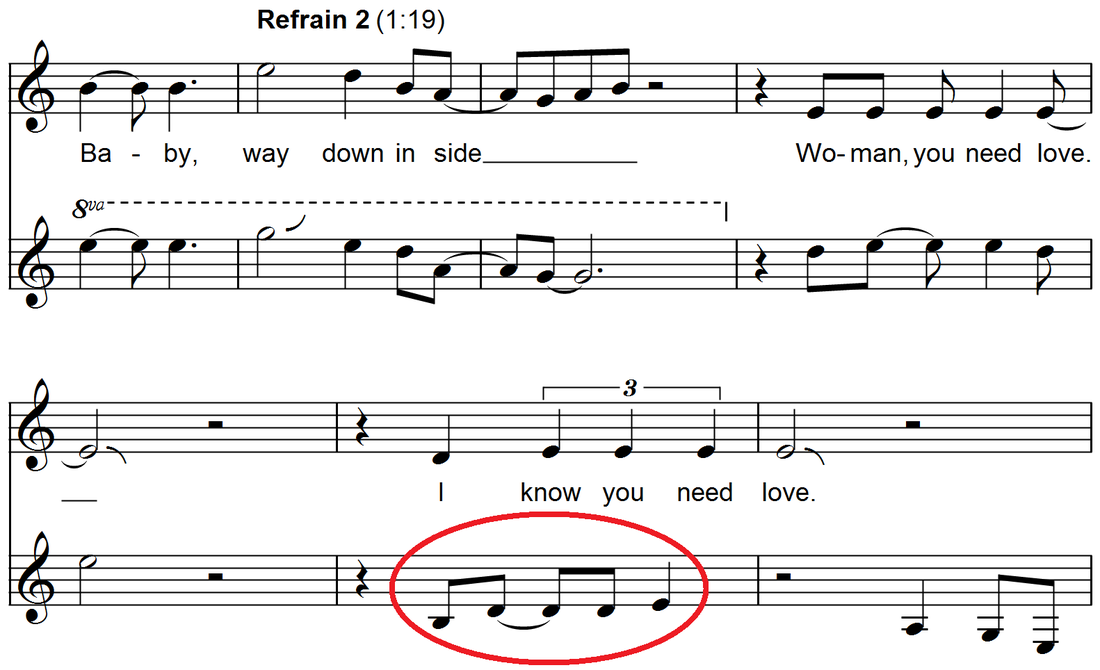|
Willie Dixon, probably the foremost blues composer of the mid-20th Century, penned a song titled 'You Need Love', which he gave to Muddy Waters to record in 1962. Seven years later, that song's lyrics would be the inspiration for Led Zeppelin's 'Whole Lotta Love'. Muddy Waters: 'You Need Love' (1962), Third Verse (1:57-end) I ain't foolin', you need schoolin' Baby, you know you need coolin' Woman, way down inside Woman, you need love You got to have some love Mmmm She got to have some love Mmmm She got to have some love Led Zeppelin: 'Whole Lotta Love' (1969), First Verse (0:11-0:45) You need coolin', baby, I'm not foolin' I'm gonna send you back to schoolin' Way down inside, honey you need it I'm gonna give you my love I'm gonna give you my love Oh! Wanna whole lotta love Wanna whole lotta love Wanna whole lotta love Wanna whole lotta love Dixon sued Zeppelin for plagiarism in the 1980s, settling out of court for an undisclosed amount. While the lyrical similarities are undeniable, there remains some confusion whether or not the music (independent of the words) is original or not. Jimmy Page claimed the former: "If you took the lyric out and listened to the track instrumentally, it is clearly something new and different - a completely original piece of music" (English, page 198). But Zeppelin biographer Mick Wall claimed the latter: "Even the most memorable part of the song, that punchy B-D-B-D-E riff, was derived from the original guitar refrain of the Muddy Waters original" (Wall, page 149). Unfortunately, Wall provides no evidence to support his claim. Nor does he appear to understand what a refrain is. (It's a lyrical device - not a musical one - so I'm not sure how a "guitar refrain" is even possible since a guitar can't sing lyrics.) While Waters does use a refrain (corresponding to the title lyrics) three times in the song (0:19-0:40, 1:19-1:31, and 2:07-2:16 - each one slightly different in content and duration), the accompanying guitar (which more or less double the vocals) is not strongly related to the Zeppelin riff. The best example (the closest to 'Whole Lotta Love') is heard in the second of those three refrains. The circled measure does share modest similarities to 'Whole Lotta Love' in both pitch (B-D-E) and its syncopated rhythm... ... but it's only a superficial resemblance. If this is what Wall has in mind, it's a pretty weak case. It's only heard twice (once in the first refrain, once in the second), and it's not very prominent (you have to really look for it to find it). Another clue comes from author Tim English, in his book Sounds Like Teen Spirit: "The guitar lick on 'Whole Lotta Love['] is not dissimilar from what is played on Waters' 'You Need Love'" (English, page 197). English makes no mention of the refrain, so I assume he's referring to the opening guitar licks. I've transcribed the first several measures below. Yes, the fourth full measure also bears a passing resemblance to 'Whole Lotta Love' in pitch and rhythms, but I find that, too, to be more incidental than significant. I have to agree with Page (and against Walls and English) on this one: 'Whole Lotta Love' is musically independent from 'You Need Love'. There are superficial musical similarities and a strong similarity in character (they're both blues songs), but nowhere near the resemblance of the lyrics. Lastly, Robert Plant's vocals are worth mentioning. Just as he borrowed the lyrics from Muddy Waters, so too he borrows the vocal style of Steve Marriott, lead singer of The Small Faces, who released their own version of the song, 'You Need Loving', in 1966. Plant greatly admired Marriott's vocal style, calling him a "master of contemporary white blues" (Shadwick, page 262), and deliberately imitated it. And nowhere is that influence more apparent than on 'Whole Lotta Love'.
SOURCES English, Tim. 2016. Sounds Like Teen Spirit: Stolen Melodies, Ripped-Off Riffs, and the Secret History of Rock and Roll. [No publisher or city given]. Shadwick, Keith. 2005. Led Zeppelin 1968-1980. Backbeat Books; San Francisco, CA. Wall, Mick. 2008. When Giants Walked the Earth: A Biography of Led Zeppelin. St. Martin's Griffin; New York, NY.
0 Comments
“Whole Lotta Love”, the opening track from Led Zeppelin II, employs a rather conventional compound AABA structure. The verses and choruses combine to constitute the compound A sections, while the break and solo combine to create the compound B section. While The Beatles employed AABA structures frequently (121 of their 211 songs use some type of AABA design), they used relatively few compound AABA structures. The most famous of that handful is “Magical Mystery Tour”, which, though not identical to “Whole Lotta Love”, is strikingly similar in form. So what does this mean? It's an example of how Led Zeppelin grew out of what came before them. Of course this doesn't necessarily mean that Jimmy Page and Robert Plant were deliberately mimicking John Lennon and Paul McCartney – I highly doubt they were – but here we have an early Zeppelin recording that employs a similar structure to a late Beatles track. Just a few years later, Zeppelin would record “Black Dog” and “Stairway To Heaven” and “Kashmir”, all of which use much more experimental and innovative formal designs which depart from and build off of structures employed by The Beatles. And I'll look in detail at those songs soon.
|
Aaron Krerowicz, pop music scholarAn informal but highly analytic study of popular music. Archives
August 2019
Categories
All
|





 RSS Feed
RSS Feed
